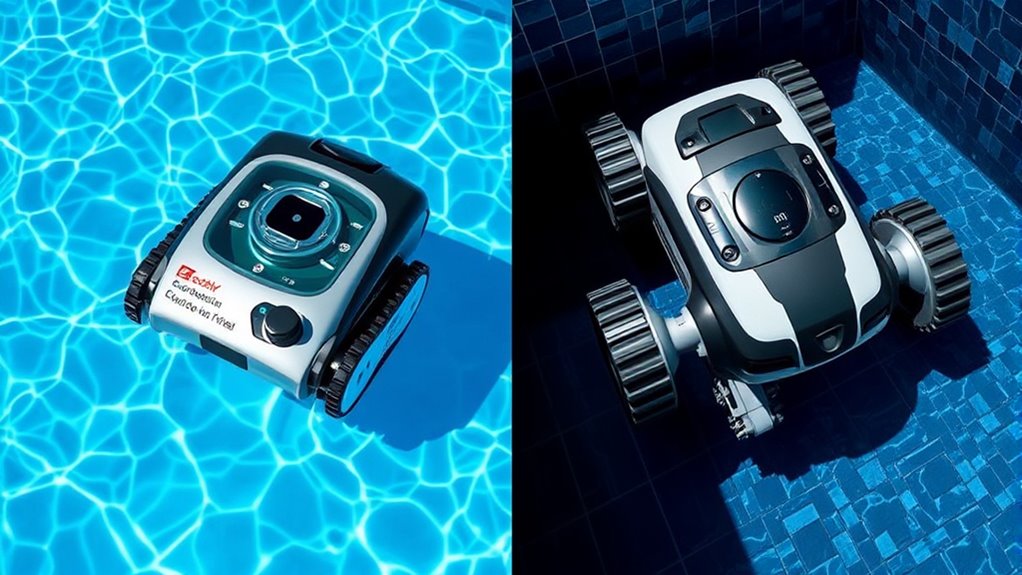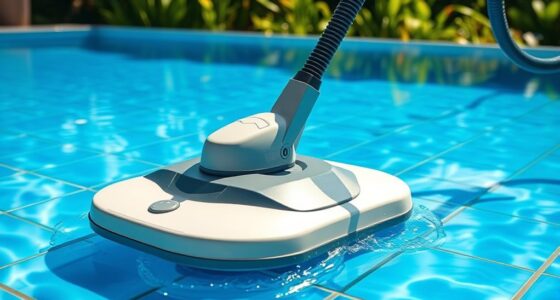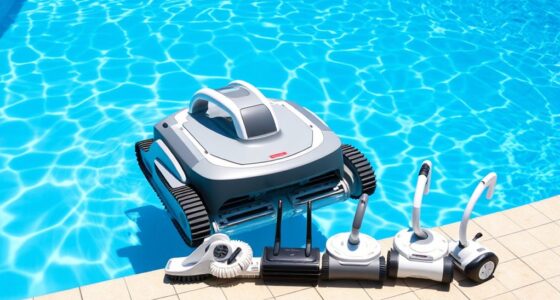Robotic pool cleaners for above-ground pools are usually smaller, lightweight, and designed for quick, easy setup, while in-ground models tend to be larger, more powerful, and equipped with advanced navigation for extensive coverage. Your choice depends on your pool size, shape, and features. If you want efficient cleaning tailored to your pool type, knowing the key differences can help. Keep exploring to discover the best options for your pool’s needs.
Key Takeaways
- Above-ground pool cleaners are smaller, lightweight, and designed for easy portability, while in-ground models are larger with advanced navigation features.
- In-ground pool cleaners often have longer battery life and more powerful motors to handle bigger and complex pool designs.
- Compatibility depends on pool size and shape; select models specifically tailored for above-ground or in-ground pools to optimize cleaning.
- Maintenance and setup vary; above-ground units are simpler to install and maintain, whereas in-ground models may require more setup and regular upkeep.
- Consider features like debris filters, cleaning modes, and navigation systems to match the pool type and ensure effective cleaning performance.
Key Design Differences and Compatibility
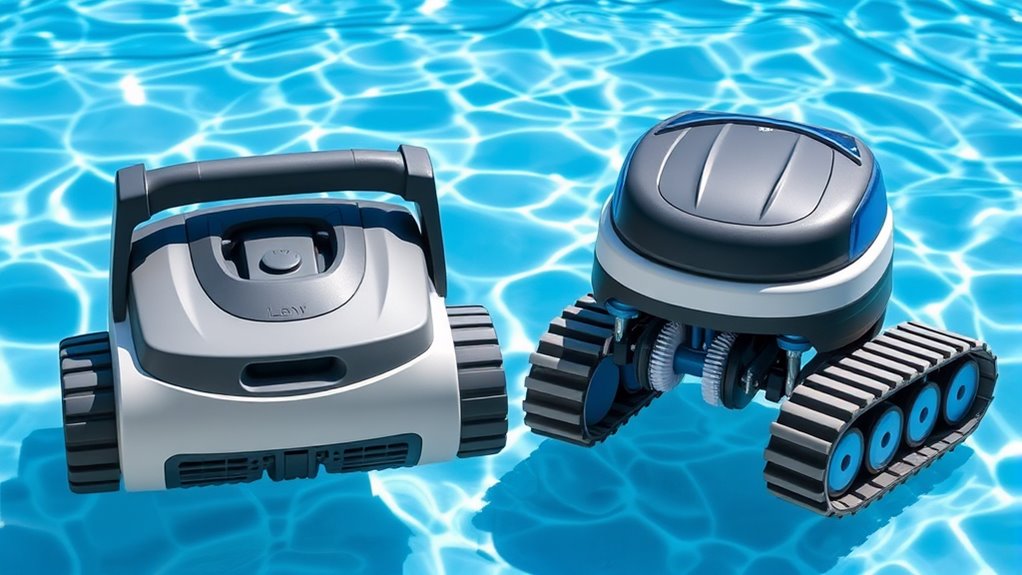
When comparing robotic pool cleaners, understanding their key design differences is essential because these variations directly affect compatibility with your pool. Your pool size plays a significant role, as larger pools require models with longer battery life and more powerful motors. In-ground pools tend to need cleaners designed for bigger, more complex surfaces, while above-ground pools often require smaller, lightweight units. Water chemistry also influences design choices; pools with high pH levels or chemical imbalances can cause mineral buildup, so select cleaners with durable brushes and filters resistant to corrosion. Some models are specifically engineered to handle various water conditions, ensuring longevity and ideal cleaning. Additionally, AI-powered features can optimize cleaning patterns and adapt to different pool environments, extending the lifespan and effectiveness of your robotic cleaner. Properly matching the cleaner’s design with your pool’s size and water chemistry can improve cleaning efficiency and ensure better performance and longer-lasting equipment. Being aware of water chemistry challenges can help you select models equipped to resist corrosion and mineral deposit issues, ultimately saving maintenance costs and extending the cleaner’s lifespan. Awareness of tuning and modifications for pool equipment can also contribute to maintaining optimal performance over time. Moreover, considering the design robustness of a model can prevent premature wear and ensure consistent cleaning results under various conditions.
Cleaning Capabilities and Features
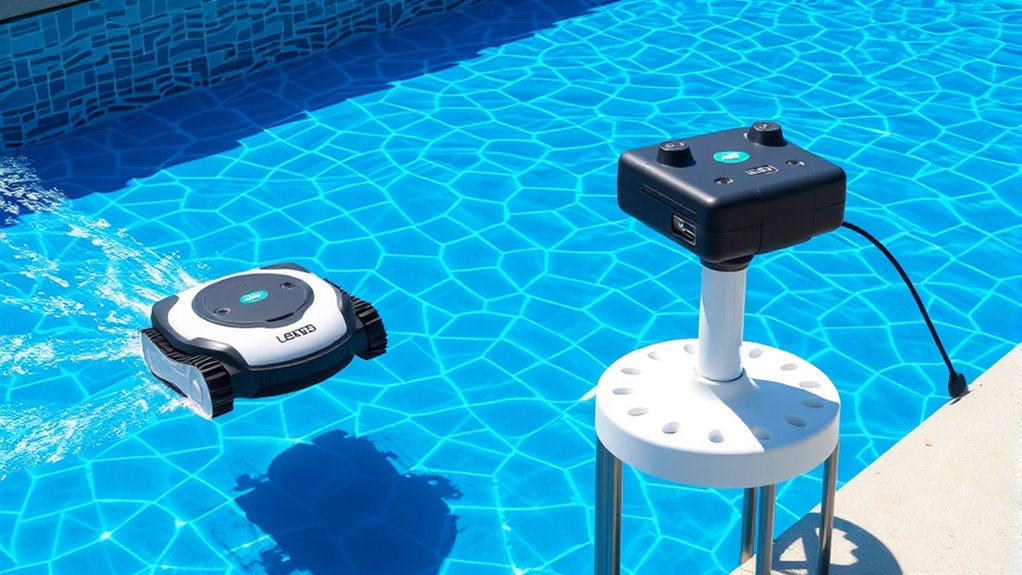
Robotic pool cleaners come equipped with a variety of cleaning capabilities and features that determine how effectively they maintain your pool. One key aspect is filter types, which can range from standard mesh to fine cartridge filters, impacting how well debris and dirt are captured. Some models feature multi-layer filters for enhanced cleaning. Battery life is another important feature; longer-lasting batteries allow for extended cleaning cycles without interruption, ensuring thorough coverage of your pool’s surfaces. Many cleaners have adjustable cleaning modes, such as spot cleaning or complete pool coverage, to suit different needs. Additional features like programmable schedules and remote control options enhance convenience. Overall, these capabilities help deliver efficient, exhaustive cleaning tailored to your pool’s size and type. Additionally, the integration of noise reduction technology in modern robotic pool cleaners ensures quieter operation, minimizing disturbances during use. Furthermore, advanced navigation systems improve coverage efficiency by allowing the cleaner to map and adapt to pool layouts more effectively. Incorporating smart technology can also enable remote monitoring and control, adding to user convenience and operational efficiency. Enhanced sensor systems further optimize cleaning paths and prevent the cleaner from getting stuck, improving overall performance. Moreover, energy-efficient motors contribute to lower power consumption, making the cleaning process more environmentally friendly and cost-effective.
Installation and Operation Considerations
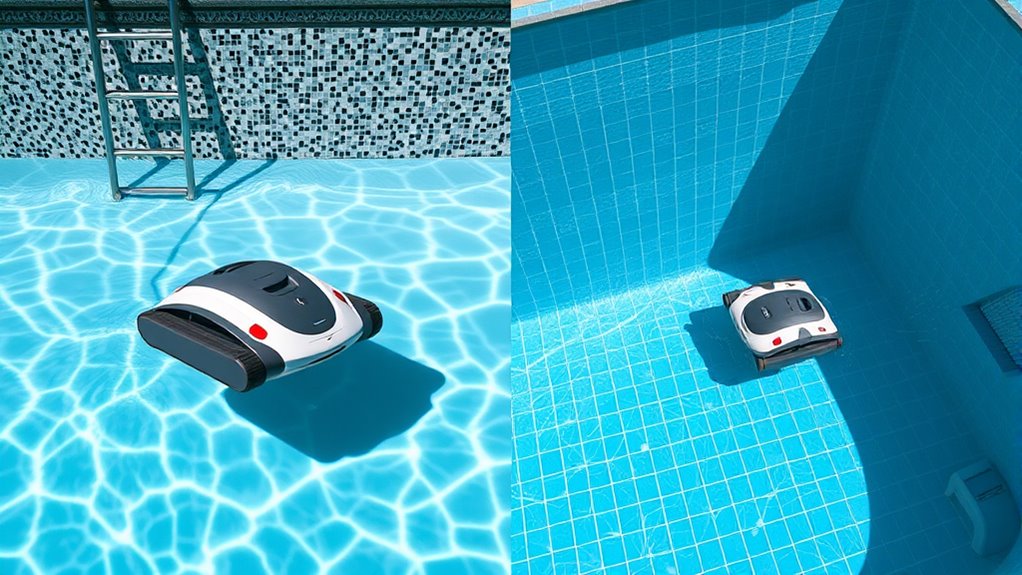
Installing and operating a robotic pool cleaner is straightforward, but paying attention to certain considerations guarantees ideal performance. First, assess your pool size to select a model with appropriate coverage and battery life. Guarantee your power supply meets the necessary power requirements for your cleaner’s operation. For above-ground pools, lightweight and portable units are easier to maneuver, while in-ground pools may need models with longer cords or specialized features. Keep in mind that:
- Larger pools may require more powerful cleaners or multiple sessions
- Power requirements vary; check voltage and amperage compatibility
- Secure and protect power cords to prevent damage or tangling
- Follow manufacturer guidelines for installation to optimize cleaning efficiency
- Understanding vacuum cleaner performance metrics such as suction power and filtration can help you choose the most suitable model for your pool size and debris type.
- Proper electrical safety measures are essential to prevent hazards and ensure safe operation, especially in outdoor environments with water and electricity.
- Regularly inspect and clean your robotic cleaner to maintain optimal functionality and prolong its lifespan. Additionally, choosing a model with adjustable cleaning modes can improve effectiveness across different debris types and pool conditions.
- Considering yoga practices to relax and keep a clear mind can also help in managing maintenance routines and troubleshooting issues more calmly.
These steps help your robotic cleaner work effectively, regardless of pool type.
Cost and Maintenance Factors
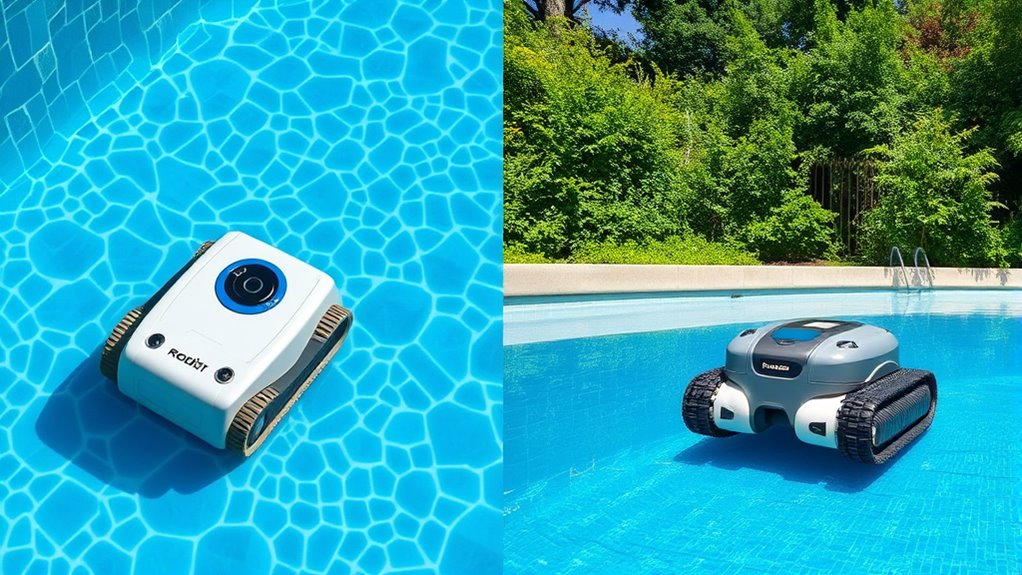
Understanding the costs and maintenance needs of robotic pool cleaners helps you make a smart investment and keep your device running smoothly. Energy efficiency plays a key role in reducing long-term expenses, as models with better power management consume less electricity. Regular maintenance, like cleaning filters and checking brushes, ensures maximum performance and extends the cleaner’s lifespan. Warranty coverage is also important—it can save you money on repairs if issues arise within the coverage period. Higher-quality models often come with detailed warranties, offering peace of mind. Additionally, considering top-rated models can help you select a reliable and efficient cleaner. While upfront costs vary, investing in a reliable, energy-efficient cleaner with solid warranty coverage can lower your overall maintenance costs and keep your pool spotless without frequent repairs. Proper maintenance routines are essential for prolonging the lifespan of your robotic cleaner and maintaining optimal performance.
Choosing the Right Robotic Cleaner for Your Pool Type
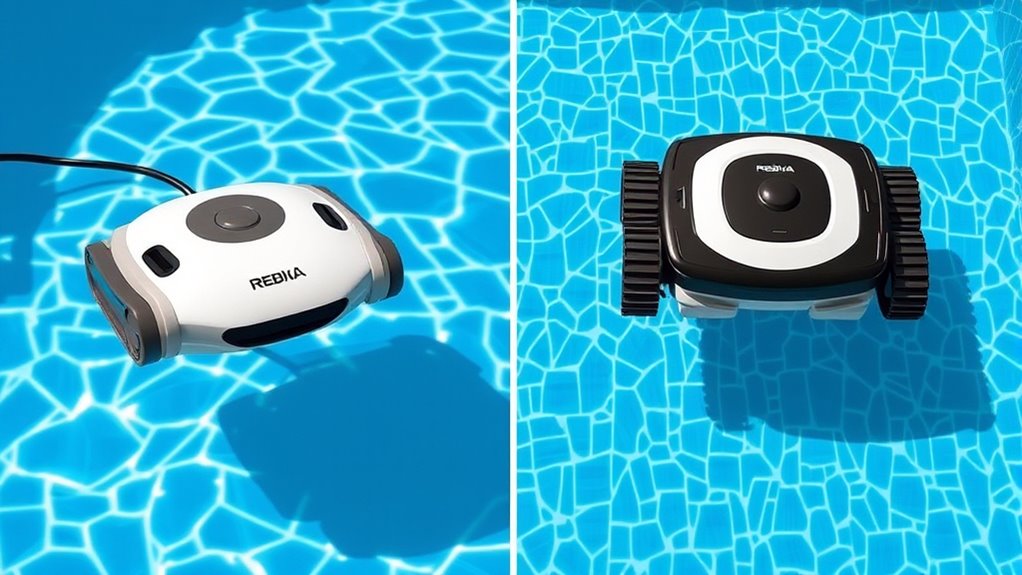
Choosing the right robotic cleaner depends on your pool’s specific type and features. For your pool size, consider models designed for small above-ground pools or larger in-ground ones to ensure efficient cleaning. Your user preferences matter too—if you want quick, thorough cleaning or energy efficiency, select a model that matches your needs. Additionally, understanding the design elements of a farmhouse bedroom can help you select a style that complements your space and enhances its rustic charm. Here are key factors to contemplate:
- Pool size: Larger pools need more powerful, longer-lasting cleaners.
- Pool shape: Irregular shapes may require customizable or more flexible cleaners.
- Cleaning features: Focus on models with filtration, scrubbing, or specialized brushes.
- Ease of use: Choose user-friendly models with simple controls and maintenance.
- Considering automatic cleaning capabilities can also improve overall efficiency and reduce manual effort. Matching these factors to your pool type and personal needs ensures you’ll find a robotic cleaner that works best for you.
Frequently Asked Questions
How Long Do Robotic Pool Cleaners Typically Last?
Robotic pool cleaners usually last around 3 to 5 years with proper care. Battery lifespan varies, but most models need a replacement after a couple of years of regular use. To maximize their longevity, you should follow maintenance requirements like cleaning filters and inspecting parts regularly. Keep in mind that the quality of the unit and usage frequency also influence how long your robotic cleaner will serve you effectively.
Are Robotic Cleaners Energy-Efficient for Long-Term Use?
Did you know robotic pool cleaners use about 10-15% less energy than traditional skimmers? They’re quite energy-efficient for long-term use, reducing your energy consumption and environmental impact. You’ll find they operate quietly and consume less power, saving you money on electricity bills over time. So, if you’re eco-conscious, investing in a robotic cleaner is a smart move that benefits both your pool and the planet.
Can Robotic Cleaners Handle Algae and Heavy Debris?
Robotic pool cleaners can handle algae removal and heavy debris handling effectively, but their performance varies. They’re great for routine cleaning, but for stubborn algae or large debris, you might need to pre-treat the pool. Look for models with strong suction and brushes designed for algae removal. Regular maintenance guarantees they stay efficient. With the right cleaner, you’ll keep your pool sparkling and free of heavy debris and algae.
Do Robotic Pool Cleaners Work With Smart Home Systems?
Ever wondered if your robotic pool cleaner can sync with your smart home system? The answer is yes, many models now offer smart home compatibility, allowing you to control cleaning schedules remotely. Imagine effortlessly scheduling your robotic cleaner to start just before you get home, knowing your pool will be spotless. This seamless integration elevates your pool maintenance, making it smarter and more convenient than ever before.
What Safety Precautions Should Be Taken When Using Robotic Cleaners?
When using robotic pool cleaners, you should prioritize pool safety by keeping the area clear of obstacles and making certain the device is designed for your pool type. Always unplug the cleaner before maintenance to prevent electrical hazards. Regularly inspect cords and connections for damage. Never operate the cleaner in wet conditions outside the pool, and follow manufacturer instructions carefully to minimize risks and ensure safe, efficient cleaning.
Conclusion
Choosing the right robotic pool cleaner is like finding your own Excalibur—tailored to your pool’s unique needs. Whether you have an above-ground or in-ground pool, understanding their differences ensures you wield the perfect tool to keep your water pristine. With a bit of research, you’ll conquer dirt and debris with ease, transforming your pool into a legendary oasis. Immerse yourself confidently—your perfect robotic helper awaits, ready to make every swim legendary.
